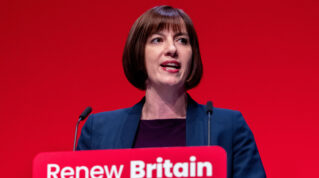The government believes schools can find savings through adjusting the make-up of leadership teams and deployment of support staff, as it prepares to leave them to foot the bill for future teacher pay rises.
The Department for Education also pointed to “opportunities to drive value for money” in academy CEO pay, adding data on executive pay to its school financial benchmarking tool for the first time.
Ministers yesterday published their evidence to the School Teachers’ Review Body on pay for 2026-27, 2027-28 and 2028-29. Here’s what we learned…
1. DfE believes 6.5% over 3 years is ‘appropriate’…
The DfE believes a 6.5 per cent pay rise over the next three years would be “appropriate”.
The department said it would “support schools to manage the challenging affordability position” in the 2026-27 financial year, “which has resulted from the significant pay uplift in 2025-26, preceded by a substantial pay uplift in 2024-25″.
In its evidence, it said such a rise would “maintain the competitiveness of teacher pay and provide a real terms improvement over the parliament”.
2. … and should be weighted towards the end of the period
The DfE also said the level of awards should be “weighted towards the latter part of the remit”.
Its “central expectation is that 2026-27 is likely to be the year when headroom will be most constrained at a national level and where schools will have had the least planning time to implement any changes and in ways which best deliver for children”.
3. Schools will have to pay for it themselves
The report repeatedly refers to the “challenging fiscal context” and states schools will need to find savings to cover the proposed pay rises. It also refers multiple times to the government’s spending review settlement for schools.
“While this investment is both welcome and necessary, it is vital to strike a balance,” the report said.
“Going beyond the proposal set out in written evidence over the SR [spending review] period would place significant pressure on school budgets, especially in 2026-27.”
The government “expects that most schools will need to implement plans to realise and sustain better value from existing spend in addition to the funding being provided through the core schools’ budget to deliver the pay awards”.
4. DfE predicts savings on leadership and support staff
The DfE said it acknowledged opportunities to make savings “vary across individual schools, reflecting differences in context and operational models”.
However, it said “several common themes have emerged” as schools seek to save cash, and schools have “identified and acted upon opportunities” in some areas.
This includes reviewing their reliance on supply and “reconsidering the composition of their leadership teams”.
“There has been a 45 per cent increase in assistant 40 headteacher positions since 2011-12, indicating some room to drive better value from spending.”
There is “space for schools to optimise the deployment of support staff to enhance their impact on pupil learning and development.
“As an example, the workforce data shows a 30 per cent increase in teaching assistants, compared to a 7 per cent increase in teachers since 2011.”
5. ‘Increasing’ CEO pay added to benchmarking tool
The DfE also said it was “aware of trends of increasing executive pay and monitors this through an annual engagement exercise”.
It said there were “opportunities to drive value for money in this area”.
The department has introduced executive pay into its financial benchmarking and insights tool “to encourage boards to make evidence-based decisions when setting executive pay”.
6. ‘New programme’ to help schools save
The DfE pointed to several existing programmes aimed at helping schools save money.
But it also said it aimed to “establish a new programme shortly to help schools and groups seize opportunities to maximise value from every pound.
“This is a shared responsibility, so the department will tackle the systemic issues that drive costs and prevent schools and groups from getting the best value for money and provide support to schools and groups in four key areas where we know there are opportunities to drive better value.”
These areas are commercial spend, assets including reserves, workforce deployment and “tackling barriers to further improvements to driving value from their resources, particularly through AI and technology”.
“The new programme will provide an expanded level of support to schools and groups in the form of benchmark data, toolkits, commercial offers, capability building, case studies and investment in areas such as technology.”
7. Salary safeguarding could decrease or taper
In its remit letter to the STRB in July, the government also asked the body to make recommendations on the future of salary safeguarding.
Salary safeguarding means teachers whose pay is due to decrease due to a change in circumstances, school restructure or move to a different school under the same employer have their pay topped up to its old level for three years after the change.
In its evidence this week, the DfE said there were “options” for changes.
“It may be that for simplicity, the salary safeguarding period is reduced to a shorter period, for example, two years rather than three years, to build in this flexibility for school leaders.
“Another option could be to taper the salary safeguarding period to avoid the sudden drop in salary, and therefore retention risk, at the end of the period.”
8. Consider ‘merits and challenges’ of 1,265 hours reform
Earlier this year, Phillipson also ordered a review of directed time, which she said is “potentially creating a constraint on schools’ deployment of teachers”.
Directed time is a rule in teachers’ pay and conditions that stipulates they cannot be “directed” to work more than 1,265 hours across the school year. In reality, teachers’ average working hours are much greater.
In its evidence, the DfE asked the STRB to “thoroughly consider the merits and challenges of any reform for maintained schools”.
“Additional factors” to consider include the previous government’s non-statutory expectation of a 32.5-hour school week and the fact the 39-week school year means teachers’ annual working hours “cover shorter, more intense periods”.
9. 193 accepted onto teaching apprenticeship for non-grads
The first teaching degree apprenticeship for non-graduates was introduced last October. The four-year course gives trainees a degree qualification and leads to qualified teacher status.
In its evidence, the DfE said the first recruitment cycle for academic year 2025-26 “has seen 193 acceptances as of 15 September and high candidate interest and applications in this new route into teaching.
“The department expects this route to open the profession to those that would not otherwise be able to train to become teachers.”
10. DfE trials ‘anonymised recruitment’ through ‘Apply’ service
The report acknowledged “disparities” in teacher training recruitment based on trainee characteristics.
To address them, the DfE said it was “trialling anonymised recruitment” through the “find a candidate” section of its digital application service, “Apply”.
“Candidates’ names and dates of birth are being obscured to support fairer decision-making. Candidates’ ethnicity, sex, and disability information is already obscured during the recruitment process.”














Intriguing that the hugely increased roles for school in providing social care, health care, SEND provision within mainstream and safeguarding responsibilities is not acknowledged as a fundamental driver for the increased Leadership and TA employment. These are not cost saving opportunities, they are examples of government cost savings hidden within schools.